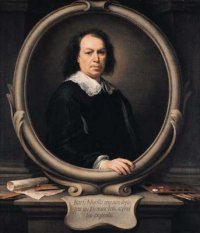On this day in 1682, the Spanish painter Bartolome Esteban Murillo died, at sixty-five years of age. He was well loved in his home town of Seville, according to the early biographer Antonio Palomino, where his sweetly familial depictions of the Holy Family earned him a reputation as an irreproachably pious and decorous artist. Indeed, according to Palomino, “Our Murillo was also so modest that we can say that he died of pure decorousness; for being up on a scaffolding in order to paint a very large picture of saint Catherine that he was doing for the Capuchin Convent in the city of Cadiz, he stumbled going up this scaffolding, and because his intestines were ruptured, they came out; and so as not to manifest his weakness or allow himself to be examined he died of this accident…”
This week’s picture is Murillo’s beautiful, sombre self-portrait, painted roughly a decade before the accident that cut short his life, in about 1670-73. The work can be seen in the National Gallery in London. The artist places his own likeness within a stone cartouche or frame, a device borrowed from the engraved frontispieces of many seventeenth-century books. This suggests that he intended the work to serve a kind of memorial function – a portrait of the artist that might, after his death, serve as an introduction to the considerable volume of his works. Murillo was in his illustrious late middle age when he painted the picture, and was incontestably the leading painter in Seville. Many of the city’s churches contained altarpieces by his hand, and such was the fame of his graceful Madonnas and endearing infant saints that his fame had eclipsed even that of his venerable compatriot Diego Velazquez.
The artist wears a sober black costume, lightened...


